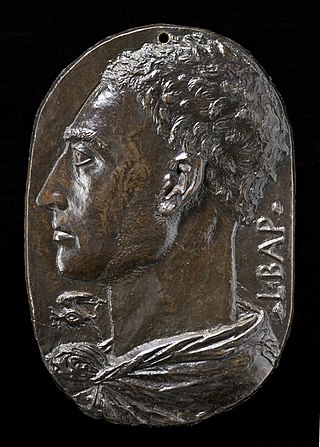
Leon Battista Alberti was an Italian Renaissance humanist author, artist, architect, poet, priest, linguist, philosopher, and cryptographer; he epitomised the nature of those identified now as polymaths. He is considered the founder of Western cryptography, a claim he shares with Johannes Trithemius.

Santa Maria Novella is a church in Florence, Italy, situated opposite, and lending its name to, the city's main railway station. Chronologically, it is the first great basilica in Florence, and is the city's principal Dominican church.
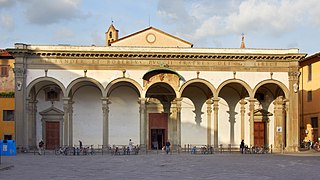
The Basilica della Santissima Annunziata is a Renaissance-style, Catholic minor basilica in Florence, region of Tuscany, Italy. This is considered the mother church of the Servite Order. It is located at the northeastern side of the Piazza Santissima Annunziata near the city center.
Tempietto generally means a small temple-like or pavilion-like structure and is a name of many places in Italy:
The Church of the Holy Sepulchre is a church in the Christian Quarter of the Old City of Jerusalem, believed to be the site of Jesus Christ's empty tomb.
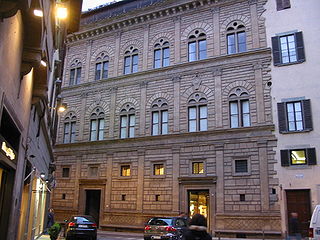
Palazzo Rucellai is a palatial fifteenth-century townhouse on the Via della Vigna Nuova in Florence, Italy. The Rucellai Palace is believed by most scholars to have been designed for Giovanni di Paolo Rucellai by Leon Battista Alberti between 1446 and 1451 and executed, at least in part, by Bernardo Rossellino. Its splendid facade was one of the first to proclaim the new ideas of Renaissance architecture based on the use of pilasters and entablatures in proportional relationship to each other. The Rucellai Palace demonstrates the impact of the antique revival but does so in a manner which is full of Renaissance originality.
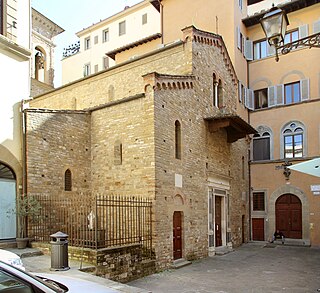
The Church of Santi Apostoli is a Romanesque-style, Roman Catholic church in the historic center of Florence, in the Tuscany region of Italy. It is among the oldest church buildings in Florence.
The Platonic Academy of Florence was an informal discussion group which formed around Marsilio Ficino in the Florentine Renaissance of the fifteenth century.
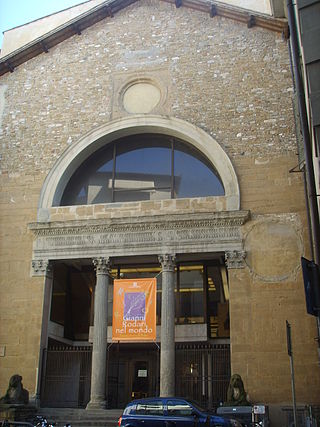
San Pancrazio is a church in Florence, Italy, in Piazza San Pancrazio, behind Palazzo Rucellai. With the exception of the Rucellai Chapel, it is deconsecrated and is home to the museum dedicated to the sculptor Marino Marini. The Rucellai Chapel contains the Rucellai Sepulchre or Tempietto del Santo Sepolcro. Since February 2013 it has been possible to visit the chapel from within the Marini museum.

The Loggia Rucellai is an Italian Renaissance loggia in Florence, Italy. It stands opposite Palazzo Rucellai in the Via della Vigna Nuova, and faces onto Piazza de' Rucellai. It was built by Giovanni di Paolo Rucellai in the 1460s; it may have been designed by Leon Battista Alberti, but this attribution is disputed. Originally intended as a place for the Rucellai family to have weddings and other celebrations, it is now glazed and used as a shop.

Bernardo Rucellai, also known as Bernardo di Giovanni Rucellai or Latinised as Bernardus Oricellarius, was a member of the Florentine political and social elite. He was the son of Giovanni di Paolo Rucellai (1403–1481) and father of Giovanni di Bernardo Rucellai (1475–1525). He was married to Nannina de' Medici, the elder sister of Lorenzo de' Medici, and was thus uncle to Popes Leo X and Clement VII, who were cousins. Oligarch, banker, ambassador and man of letters, he is today remembered principally for the meetings of the members of the Accademia Platonica in the Orti Oricellari, the gardens of his house in Florence, the Palazzo Rucellai, where Niccolò Machiavelli gave readings of his Discorsi.
A zibaldone is an Italian vernacular commonplace book or notebook containing a wide variety of vernacular texts, copied into a small or medium-format paper codex by citizens in late-medieval and Renaissance Italian city-states.
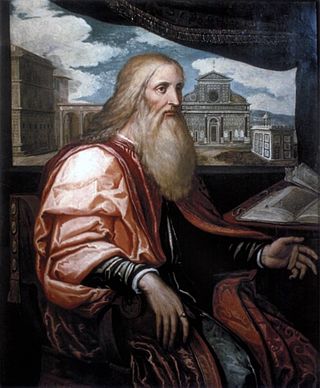
Giovanni Rucellai, known by his name with the patronymic Giovanni di Paolo Rucellai, was a member of a wealthy family of wool merchants in Renaissance Florence, in Tuscany, Italy. He held political posts under Cosimo and Lorenzo de' Medici, but is principally remembered for building Palazzo Rucellai and the Rucellai Sepulchre, for his patronage of the marble façade of the church of Santa Maria Novella, and as author of an important Zibaldone. He was the father of Bernardo Rucellai (1448–1514) and grandfather of Giovanni di Bernardo Rucellai (1475–1525).

The Palazzo Pazzi, also known as the Palazzo della Congiura or Palazzo Pazzi-Quaratesi is a Renaissance-style palace. It is located on Via del Proconsolo 10 at the corner with Borgo Albizzi in Florence, region of Tuscany, Italy. The palace is between the Palazzo Nonfinito and the Palazzo Pazzi-Ammannati to the north.
Bruno Sacchi was an Italian architect and collaborator of Giovanni Michelucci. He is known for his work on the Museo Marino Marini at the former church of San Pancrazio in Florence, the Museo Marino Marini at the TAU Convent in Pistoia, collaborations with Giovanni Michelucci and designs of private houses.

Marino Marini (1901–1980) was one of the most important Italian artists of the twentieth century, especially as a sculptor. He was born in Pistoia, but he studied art in Florence, before moving to Monza as a teacher and finally arriving at the prestigious Academy of Fine Arts of Brera in Milan. The museum houses the second-largest collection of his works, after collection dedicated to him in his hometown.

Giovanni di Piamonte was a 15th-century Italian painter. The date and place of his birth are not known, but his name indicates that he was born in Piamonte near the present-day town of Pontassieve in Tuscany. He trained in the circle of Piero della Francesca and was one of his assistants.

The Terra Sancta Museum is a network of museums managed by the Custody of the Holy Land and located in the Old City of Jerusalem. It originated from the first "Museum of the Franciscan Fathers" opened in 1902 to exhibit the results of archaeological excavations conducted in the Holy Land by the Studium Biblicum Franciscanum. Today it includes the Terra Sancta Museum - Archaeology situated at the Church of the Flagellation and the Terra Sancta Museum - Art and History located at the Monastery of Saint Saviour.


























